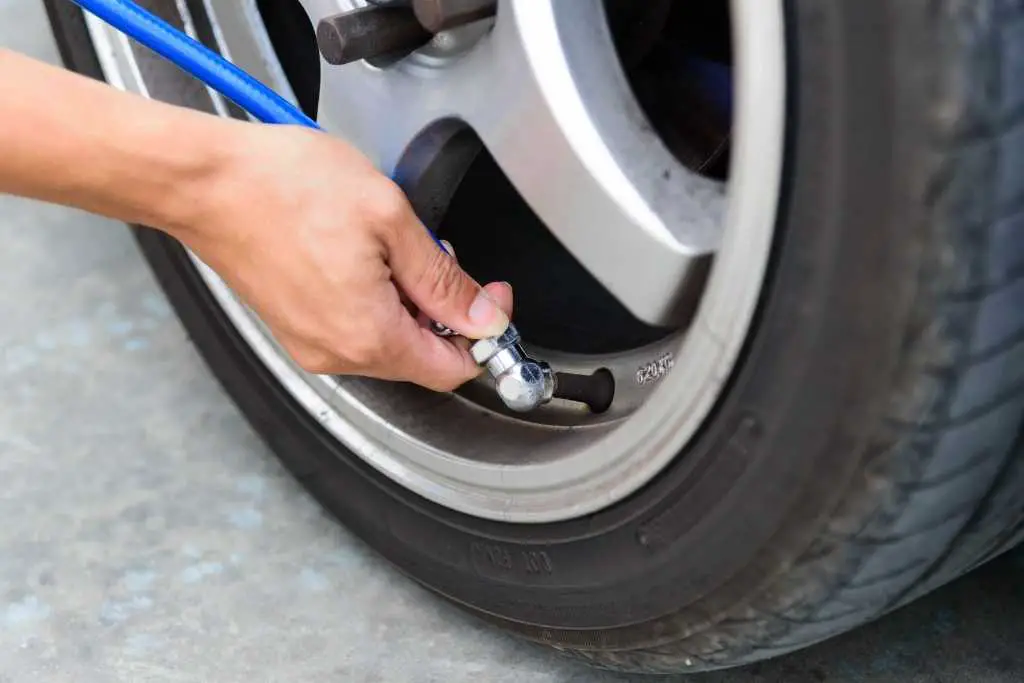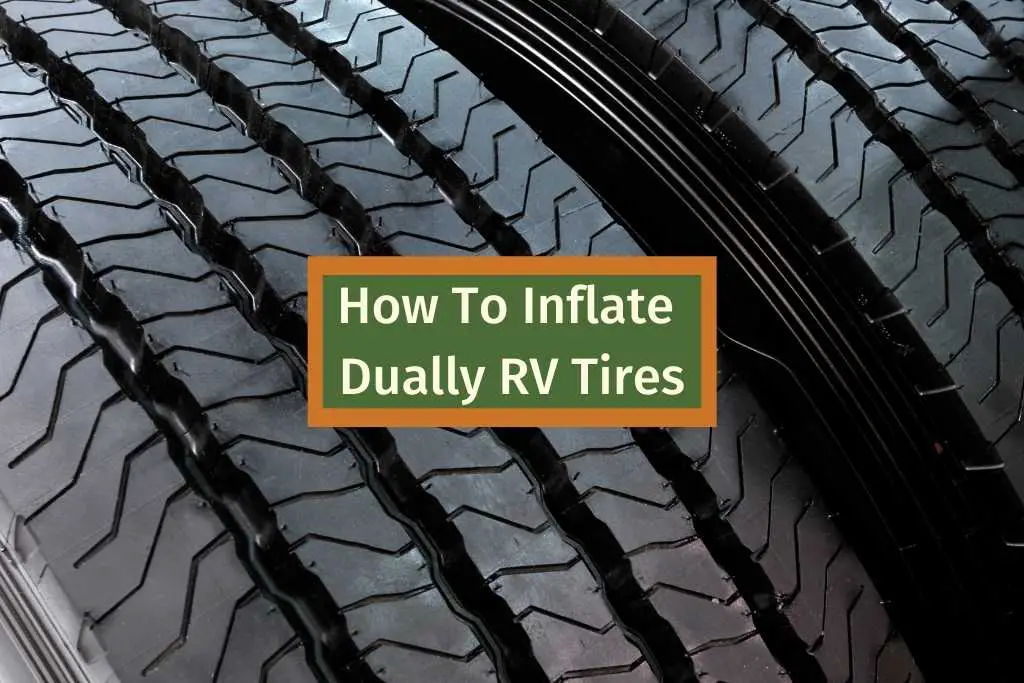Every RV owner will need to know how to inflate their RV tires, whether they are dual tires or not. If your RV does have dual tires (also called dually or duallies) then it’s a slightly harder process. So, to answer the question how to inflate dual RV tires, read on.
To inflate RV Dual tires you will need to access the tire valve on both the outer and inner tires. Attach the chuck to the valve stem and attach a high pressure air compressor – usually 80PSI and fill the tires to their PSI rating.
It’s important to check that your tires are properly inflated, especially before a trip. Dually tires can be a bit more tricky to look after, but hopefully your questions will be answered in this article.
What are Dual Tires?
Some larger vehicles like trucks and RV have two pairs of tires on the rear axle, these are called dually tires, dual tires duallies.
The four tires on the rear axle help increase the load and towing capacity of the vehicle, as the weight is spread across more area.
Dual rear tires appeared on a Chevy pickup truck in 1973. They were available on heavy duty vehicles before then but this was the first non commercial application of the tires.
The dually tires proved to be popular and a stylish design, they are still around today on modern RVs and trucks.
They are most prevalent on Class A and Class C motorhomes, and some pickups have them. This is useful if you have a pop up camper for the back of your truck.
What is the Purpose of A Dual Tire?
Having dual tires on the rear axle gives extra stability and safety when there is a heavy load, this is especially true for RVs or trucks towing heavy trailers. The extra tires help to spread the weight distribution of the load.
Because of the extra surface area the extra tires provide there is more contact with the road which helps with traction and stability.
Another bonus of dual tires on your RV or truck is that if one blows out it’s easier to maintain control as you still have three tires on the rear axle. This makes it safer to drive and pull over.
However, there are some disadvantages to having dual tires:
- More Expensive – you have two more tires to buy and maintain, and as we all know RV tires aren’t cheap.
- Registration – some states require trucks and RVs with dually tires to register as a commercial vehicle, whether it is or not. Check with your location as to whether you have to do this.
- Size – RVs and trucks with dual tires are wider to fit the extra tires in, this can make them even more tricky to park and maneuver.
- Comfort – Dually vehicles are more susceptible to bumps, especially when empty, you may find that you bounce around more.
- Hydroplane – Because of the wider area of the tires they are more prone to hydroplaning in wet conditions. Bear this in mind and drive extra carefully when conditions are wet or icy.
If your RV does start to hydroplane, do not slam on the brakes. Press your foot lightly on the gas and steer as straight as possible to a dryer patch of road. Keep your tires well maintained with good tread and pressure to reduce the chances of hydroplaning.
How Long Do Dual Tires Last?
How long your dually tires last depends on your truck or RV, the weight and driving conditions will all impact how long they last. Most RVers get between 35,000 to 50,000 miles out of dually tires. Dually tires will tend to last longer than the front tires.
It’s recommended that all four dually tires are replaced at the same time. If you notice the inner tires are wearing down quicker move them to the outside, or vice versa.
If you are replacing all four and have some wear left on one or two of the dual tires then you can move them to the front or keep them as spare.
How To Inflate Dually RV Tires
The first thing you need to check when inflating RV dual tires is the recommended PSI, it’s usually higher than normal at around 80. You will need to make sure that you have an air compressor that will go to that PSI.
Inflating the outside dual tire is the same as with any tire, remove the stem cap and attach the air compressor hose chuck to the valve. Set the air compressor to the desired PSI and fill the tire, by squeezing the trigger until the air compressor indicates that the tire is at the right pressure.
Inflating the inside tire is done in the same way, the tricky part is accessing the stem valve. If your dual tires are aligned then the stem will be easily accessible through the gap in the outer wheel. If they are not aligned then that’s the tricky part.
You will have to remove the outer tire, I usually inflate the inner tire while this is removed for ease. When you replace the outer tire make sure that it is properly aligned with the inner tire so you can easily reach the stem valve. This will save you from having to remove the tire every time you want to check the pressure or inflate the inner tires.
Having your own air compressor is essential, it will save you countless trips to the gas station and truck stops. Just make sure that you buy the best air compressor for your needs, as some air compressors don’t go up to 80 PSI.
You will also want an air compressor that has a long enough hose to reach both tires, a 12 inch hose is the minimum you will need to get the job done.

Tools To Help Inflate Dually Tires
To make life a bit easier there are tools available to help you inflate your dually tires. I’d recommend an angled inflator chuck if you just need that bit extra to reach. A tire stem extension will make it much easier to inflate the inner tire. You could also install a tire pressure equalization system which will combine the pressure of the two tires.
Angled Inflator Chuck
If you are struggling to get the right angle to connect the air compressor to the inner tire then you may need an angled inflator chuck.
This is an inexpensive piece of equipment that you attach to the end of your air compressor hose and it will give you that extra reach an maneuverability to connect to the inner tire.
Alternatively you could use a tire stem extension like this one from amazon.
Tire Stem Extension
A tire stem extension can be installed on the inner tire so you can easily reach the valve to check the pressure or inflate it.
Good quality ones are made from stainless steel and attach to the inner tire valve and are secured in place on the outer wheel.
This makes any air top up a breeze because you don’t have to worry about trying to get a good grip on the inner tire valve.
These tire stem extensions from Amazon are a great option, they are made from heavy duty stainless steel with durable copper nuts and alloy clip. There are 4 pieces in the pack so you’ll have a couple spare.
Just be aware that you will still have to align your tires in the first place so it won’t get you out of that bit of hard work. Once fitted though they will save you lots of time fiddling to try and attach the air compressor to the inner tire.
You will also need to make sure that they are secured really tightly, if they become loose when driving they can do a lot of damage to your tires and wheels.
Tire Pressure Equalization System
A tire pressure equalization system lets the air from the inner and outer tires flow between each other, thus equalizing the pressure.
This will save you time and money as it will increase the longevity of your tires, and save on fuel costs.
Even if your tires have just been filled, when you are driving the inner tire’s pressure increases more than the outer. This is due to in-board brakes and poor air circulation.
If tires are at too high of a pressure they will deteriorate quicker and can even blow out. A tire pressure equalization system helps to prevent this by spreading the pressure between the two tires evenly, so the inner tires will last longer.
The Crossfire Dual Tire Pressure Equalization System is a great system, it will show you the pressure of your tires and maintain equal tire pressure. This helps with fuel costs, the life span of the tires and improves safety, stability and braking.
The Crossfire system bolts to the lug, hub cap, or drive axle end, when installed it allows air to freely flow from one tire to another.
How do you check air pressure on dual tires?
Just like single tires, you need to check the pressure of your dually tires before every trip. Underinflated and overinflated tires increase the likelihood of a blowout and have a big impact on the life span of your tire.
Most dual RV tires should be at 80 PSI, check your manual for your RVs tire pressure. As this is higher than most car or single RV tire pressures make sure that your air compressor or tire pressure gauge goes up to that number.
You should also wait until your tires are cold to read the pressure, as warm tires after a trip will give out an artificially high pressure that’s not accurate.
When you have your tire pressure gauge and your tires are cool, attach the chuck on the gauge to the tire valve. The dial will turn and stop on the number that’s the pressure of your tire. Again the inner tires are trickier to reach, but if the tires are aligned correctly you should be able to reach the valve through the gap in the outer tire to take a reading.
I find it easier to read the pressure from an air compressor then you can fill it up at the same time. This saves reattaching hoses to the tire valves.
Tire Pressure Monitoring System
If you are paranoid about your RVs tire pressure, like me, then a tire pressure monitoring system is a godsend. It does what it says, it monitors your tire pressure and gives you live readings of the tires pressure to a display on your dashboard.
I like the Vesafe TPMS, Wireless Tire Pressure Monitoring System for RV, but there are lots of similar products on Amazon. You attach the tire pressure sensors on the valve stems of the tires, and they send a reading every 5 minutes to the display that can be mounted on your dashboard.
It will alert you immediately and an alarm will go off if something is wrong with the pressure or it detects theft.
It will save you manually checking the tire pressure before every trip.
Final Thoughts
Hopefully you now know how to read the pressure and inflate dual tires. Remember it’s important to have your tires at the right pressure to prevent tire damage and/or a blowout.
If you’re finding that accessing the inner tire is taking an age, remember there are some tools out there that will make this easier.

